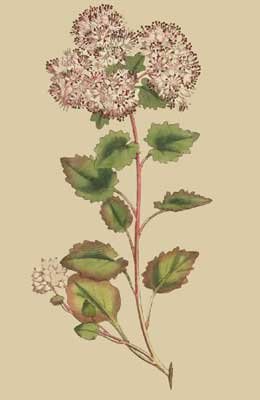Sedum Populifolium
Flowers

Sedum Populifolium
Professor Pallas, the celebrated Russian naturalist, discovered this species of Sedum in Siberia, and in the year 1780, introduced it to the royal garden at Kew, the younger Linn?us describes it minutely in his Suppl. Plantarum, and observes, that in its general form it much resembles the Saxifraga rotundifolia.Its leaves are flat as in many of the other species, and when the plant grows in an open situation, exposed to the sun, they become as well as the stalks of a bright red colour, which adds much to its beauty.It is the only hardy Sedum cultivated, in our gardens with a shrubby stalk, its leaves however are deciduous, so that in the winter it loses its verdure, it flowers in July and August, and is readily increased by cuttings.As most of this tribe grow readily, and many of them naturally on rocks and walls, they may be in general regarded as proper rock plants, some of them however are apt by the quickness of their growth to extend over and destroy plants of more value, this fault, if such it may be deemed, is not imputable to the populifolius.Some not knowing its native place of growth, keep it in the green house.
 Hemerocallis Flava Yellow Day lily
Hemerocallis Flava Yellow Day lily Dianthus Chinensis China or Indian Pink
Dianthus Chinensis China or Indian Pink Cheiranthus Maritimus
Cheiranthus Maritimus Erica Grandiflora
Erica Grandiflora Iris Variegata Variegated Iris
Iris Variegata Variegated Iris Hyoscyamus Aureus
Hyoscyamus Aureus Lopezia Racemosa
Lopezia Racemosa Saponaria Ocymoides
Saponaria Ocymoides Scabiosa Atropurpurea
Scabiosa Atropurpurea Ornithogalum Nutans
Ornithogalum Nutans Narcissus Triandrus
Narcissus Triandrus Cynoglossum Omphalodes Blue Navelwort
Cynoglossum Omphalodes Blue Navelwort Test your English Language
Test your English Language  Benefits of Plum
Benefits of Plum Benefits of Beans
Benefits of Beans Tips to get ready for Summer
Tips to get ready for Summer Azim Premji
Azim Premji What to Eat in Assam
What to Eat in Assam Tips to success in Online Business
Tips to success in Online Business How to Do Computer Yoga
How to Do Computer Yoga Summer Drinks
Summer Drinks Benefits of Jackfruits
Benefits of Jackfruits




